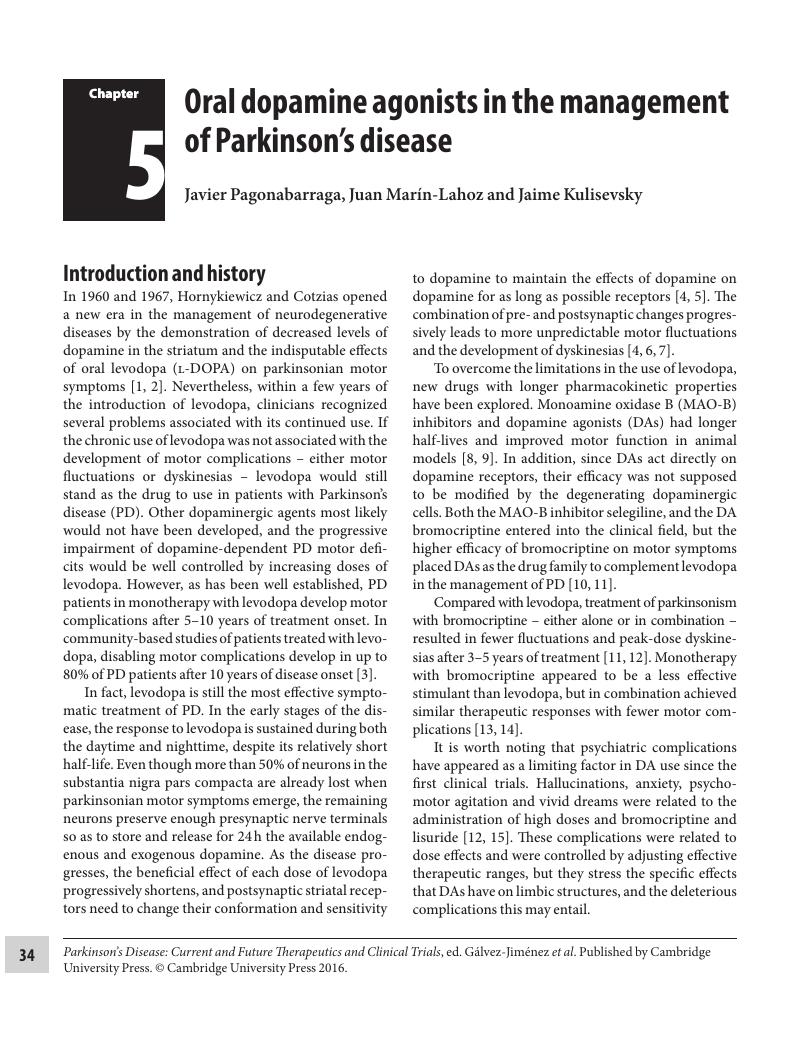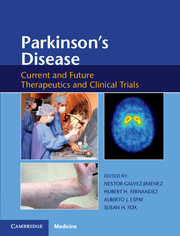Book contents
- Parkinson's DiseaseCurrent and Future Therapeutics and Clinical Trials
- Parkinson's Disease
- Copyright page
- Contents
- Contributors
- Book part
- Section I The Pharmacological Basis for Parkinson's Disease Treatment
- Chapter 1 The pharmacological basis of Parkinson's disease therapy: an overview
- Chapter 2 Anticholinergic agents in the management of Parkinson's disease
- Chapter 3 Amantadine and antiglutamatergic drugs in the management of Parkinson's disease
- Chapter 4 Monoamine oxidase inhibitors in the management of Parkinson's disease
- Chapter 5 Oral dopamine agonists in the management of Parkinson's disease
- Chapter 6 Subcutaneous, intranasal and transdermal dopamine agonists in the management of Parkinson's disease
- Chapter 7 Oral and infusion levodopa therapy in the management of Parkinson's disease
- Chapter 8 Catechol-O-methyltransferase inhibitors in the management of Parkinson's disease
- Chapter 9 Experimental pharmacological agents in the management of Parkinson's disease
- Section II Management of Nonmotor Symptoms of Parkinson's Disease
- Section III Surgical Management of Parkinson's Disease
- Section IV Clinical Trials in Parkinson's Diease: Lessons, Controversies and Challenges
- Index
- References
Chapter 5 - Oral dopamine agonists in the management of Parkinson's disease
from Section I - The Pharmacological Basis for Parkinson's Disease Treatment
Published online by Cambridge University Press: 05 March 2016
- Parkinson's DiseaseCurrent and Future Therapeutics and Clinical Trials
- Parkinson's Disease
- Copyright page
- Contents
- Contributors
- Book part
- Section I The Pharmacological Basis for Parkinson's Disease Treatment
- Chapter 1 The pharmacological basis of Parkinson's disease therapy: an overview
- Chapter 2 Anticholinergic agents in the management of Parkinson's disease
- Chapter 3 Amantadine and antiglutamatergic drugs in the management of Parkinson's disease
- Chapter 4 Monoamine oxidase inhibitors in the management of Parkinson's disease
- Chapter 5 Oral dopamine agonists in the management of Parkinson's disease
- Chapter 6 Subcutaneous, intranasal and transdermal dopamine agonists in the management of Parkinson's disease
- Chapter 7 Oral and infusion levodopa therapy in the management of Parkinson's disease
- Chapter 8 Catechol-O-methyltransferase inhibitors in the management of Parkinson's disease
- Chapter 9 Experimental pharmacological agents in the management of Parkinson's disease
- Section II Management of Nonmotor Symptoms of Parkinson's Disease
- Section III Surgical Management of Parkinson's Disease
- Section IV Clinical Trials in Parkinson's Diease: Lessons, Controversies and Challenges
- Index
- References
Summary

- Type
- Chapter
- Information
- Parkinson's DiseaseCurrent and Future Therapeutics and Clinical Trials, pp. 34 - 47Publisher: Cambridge University PressPrint publication year: 2016



